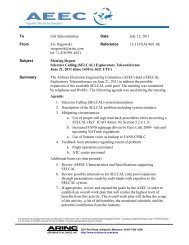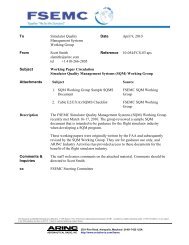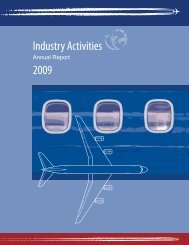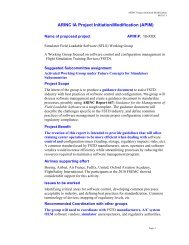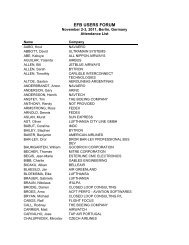(AGIE) Using Internet Protocols - Aviation Committees - AEEC - AMC
(AGIE) Using Internet Protocols - Aviation Committees - AEEC - AMC
(AGIE) Using Internet Protocols - Aviation Committees - AEEC - AMC
- No tags were found...
You also want an ePaper? Increase the reach of your titles
YUMPU automatically turns print PDFs into web optimized ePapers that Google loves.
ARINC PROJECT PAPER 830 – Page 253.0 <strong>AGIE</strong> OVERVIEWdata flow that includes status tracking and enquiry, automated reporting, logging,delivery time management, and message deletion.<strong>AGIE</strong> provides applications and administrators with the ability to determine whatlevel of message delivery status and reporting is required on a per message basis.This can be defined for each message instance, for each message type and/or foreach service invoked. Reporting may be automated or by a later request. <strong>AGIE</strong>ensures the reports and status are delivered to the originating client, whether or notit has changed hosts or is off-line when report is generated.<strong>AGIE</strong> provides built-in automated and on-demand logging features. There areaviation requirements relative to the logging of data sent to the aircraft. Loggingfunctionality is defined to facilitate efficient logging and to allow tailoring tooperational needs. Log function is required as it supports highly important functions,such as capturing security events.<strong>AGIE</strong> tracks the status of a message from origination until successful delivery, nondelivery,or timeout. A sending client can enquire about the status of a message atany time while the message is in transit via the defined message service interface.<strong>AGIE</strong> ensures transaction history is maintained. The retention period is based onregulatory and/or operational considerations and is not defined by <strong>AGIE</strong>. It is a goalfor onboard transactions and event logging to be minimized, and where possible,handled on the ground. Also, when possible, aircraft logged events areautomatically transferred to ground for permanent logging.3.7 List of OperationsThe <strong>AGIE</strong> concept of operations defines users and operations for each user. Thissection lists user operations specific to the type of user.3.7.1 Application OperationsThe following operations are initiated by end user applications via the <strong>AGIE</strong> clientinterface.1. Send message using message service (considered to be a complexoperation)2. Pull messages from <strong>AGIE</strong> server3. Manage (control/status) in transit message4. Request <strong>AGIE</strong> node/network status (ping)5. Log event6. Manage publication subscription3.7.2 Client OperationsThe following operations are initiated by <strong>AGIE</strong> client on behalf of the applications or<strong>AGIE</strong> system via client-host interface.1. Associate with <strong>AGIE</strong> host server2. Un-associate with host server3. Log event3.7.3 <strong>AGIE</strong> Server OperationsThe following operations are initiated by <strong>AGIE</strong> server via server-host and serverserverinterfaces.



